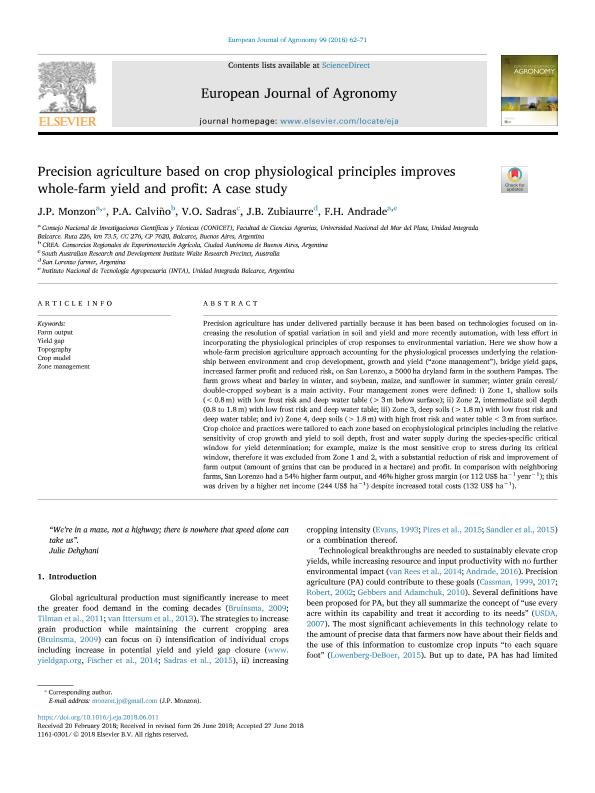Mostrar el registro sencillo del ítem
dc.contributor.author
Monzon, Juan Pablo

dc.contributor.author
Calviño, P. A.
dc.contributor.author
Sadras, Victor Oscar

dc.contributor.author
Zubiaurre, J. B.
dc.contributor.author
Andrade, Fernando Héctor

dc.date.available
2019-10-07T18:27:53Z
dc.date.issued
2018-09
dc.identifier.citation
Monzon, Juan Pablo; Calviño, P. A.; Sadras, Victor Oscar; Zubiaurre, J. B.; Andrade, Fernando Héctor; Precision agriculture based on crop physiological principles improves whole-farm yield and profit: A case study; Elsevier Science; European Journal of Agronomy; 99; 9-2018; 62-71
dc.identifier.issn
1161-0301
dc.identifier.uri
http://hdl.handle.net/11336/85293
dc.description.abstract
Precision agriculture has under delivered partially because it has been based on technologies focused on increasing the resolution of spatial variation in soil and yield and more recently automation, with less effort in incorporating the physiological principles of crop responses to environmental variation. Here we show how a whole-farm precision agriculture approach accounting for the physiological processes underlying the relationship between environment and crop development, growth and yield (“zone management”), bridge yield gaps, increased farmer profit and reduced risk, on San Lorenzo, a 5000 ha dryland farm in the southern Pampas. The farm grows wheat and barley in winter, and soybean, maize, and sunflower in summer; winter grain cereal/double-cropped soybean is a main activity. Four management zones were defined: i) Zone 1, shallow soils (< 0.8 m) with low frost risk and deep water table (> 3 m below surface); ii) Zone 2, intermediate soil depth (0.8 to 1.8 m) with low frost risk and deep water table; iii) Zone 3, deep soils (> 1.8 m) with low frost risk and deep water table; and iv) Zone 4, deep soils (> 1.8 m) with high frost risk and water table < 3 m from surface. Crop choice and practices were tailored to each zone based on ecophysiological principles including the relative sensitivity of crop growth and yield to soil depth, frost and water supply during the species-specific critical window for yield determination; for example, maize is the most sensitive crop to stress during its critical window, therefore it was excluded from Zone 1 and 2, with a substantial reduction of risk and improvement of farm output (amount of grains that can be produced in a hectare) and profit. In comparison with neighboring farms, San Lorenzo had a 54% higher farm output, and 46% higher gross margin (or 112 US$ ha−1 year−1); this was driven by a higher net income (244 US$ ha−1) despite increased total costs (132 US$ ha−1).
dc.format
application/pdf
dc.language.iso
eng
dc.publisher
Elsevier Science

dc.rights
info:eu-repo/semantics/openAccess
dc.rights.uri
https://creativecommons.org/licenses/by-nc-sa/2.5/ar/
dc.subject
Crop Model
dc.subject
Farm Output
dc.subject
Topography
dc.subject
Yield Gap
dc.subject
Zone Management
dc.subject.classification
Agricultura

dc.subject.classification
Agricultura, Silvicultura y Pesca

dc.subject.classification
CIENCIAS AGRÍCOLAS

dc.title
Precision agriculture based on crop physiological principles improves whole-farm yield and profit: A case study
dc.type
info:eu-repo/semantics/article
dc.type
info:ar-repo/semantics/artículo
dc.type
info:eu-repo/semantics/publishedVersion
dc.date.updated
2019-09-05T15:30:09Z
dc.journal.volume
99
dc.journal.pagination
62-71
dc.journal.pais
Países Bajos

dc.journal.ciudad
Amsterdam
dc.description.fil
Fil: Monzon, Juan Pablo. Universidad Nacional de Mar del Plata; Argentina. Consejo Nacional de Investigaciones Científicas y Técnicas. Centro Científico Tecnológico Conicet - Mar del Plata; Argentina
dc.description.fil
Fil: Calviño, P. A.. Asociación Argentina de Consorcios Regionales de Experimentación Agrícola; Argentina
dc.description.fil
Fil: Sadras, Victor Oscar. Universidad Nacional de Mar del Plata; Argentina. South Australian Research And Development Institute; Australia
dc.description.fil
Fil: Zubiaurre, J. B.. San Lorenzo Farmer; Argentina
dc.description.fil
Fil: Andrade, Fernando Héctor. Unidad Integrada Balcarce; Argentina. Consejo Nacional de Investigaciones Científicas y Técnicas. Centro Científico Tecnológico Conicet - Mar del Plata; Argentina. Universidad Nacional de Mar del Plata; Argentina
dc.journal.title
European Journal of Agronomy

dc.relation.alternativeid
info:eu-repo/semantics/altIdentifier/doi/https://doi.org/10.1016/j.eja.2018.06.011
dc.relation.alternativeid
info:eu-repo/semantics/altIdentifier/url/https://www.sciencedirect.com/science/article/pii/S1161030118302533?via%3Dihub
Archivos asociados
